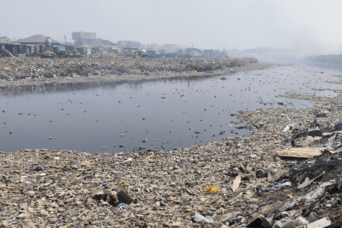The day plastic waste almost caused a war
Plastic pollution
17 April 2023
The issue of global plastic pollution tells the story of the inequalities of our time.
While Western countries are the biggest producers of waste, it is the countries of the South that suffer the impact of this pollution most violently. Until the day when...

January 2019 – Diplomatic relations between Canada and the Philippines are at their worst.
“We are not the dumping ground of the world” Rodrigo Duterte, former president of the Philippines, puts his foot down. “We are ready to go to war with Canada. We can take them down. I will send their garbage back to them, just wait and see.”
After a violent diplomatic battle and an all-out embargo, the Philippines is sending back thousands of tons of intentionally misreported waste to Canada in May 2019.
This waste trafficking dispute comes against a very unique backdrop. In 2017, the Philippines saw a 150% increase in plastic waste imports compared to 2016, reaching approximately 11,800 tons in 2018. The Philippine archipelago is suffocating under waste.
Other Southeast Asian countries have experienced the same influx: waste imports have increased by 56% in Indonesia, doubled in Vietnam and increased in Thailand by 1,370% (yes, you read that right!)¹
What happened? To understand it, we have to look at the global waste circuits.
In 2017, advocating a drastic environmental policy, the People’s Republic of China says stop and suddenly institutes a ban on waste imports into the territory. This is the “Plastic National Sword” operation.
While it used to receive more than half of the plastic waste marketed in the world, i.e. nearly 50 million tons of solid waste per year, it now receives only 1%.
The exporting countries are not responding. Without alternatives, the total volume of plastic trade is decreasing dramatically: global trade halved in 2017. Countries are forced to manage their waste on a more local scale.
Soon, other countries are taking China’s place as major importers. Most of them are also Asian countries – the Philippines but also Malaysia, Vietnam, Indonesia and Turkey are starting to import much more plastic than in previous years…
What these countries have in common is that they are vulnerable, developing economies, where labor is very cheap and environmental standards are not yet complete. But the volumes received are reaching such proportions that the receiving countries are quickly becoming “fed up” with being considered as the dumping grounds of the Northern countries.
At the heart of this global traffic are glaring inequalities in waste management and, as a result, increased marine pollution
In fact, investments in the development of adequate waste management structures are not keeping pace in the countries targeted by plastic waste trafficking, creating a greater likelihood that this waste will be poorly managed… and thus contributing to further ocean plastic pollution.
For example, while Western countries produce more plastic waste per person (an American produces eight times more plastic waste than a Chinese), the amount of mismanaged waste per capita is 100 times higher in the Philippines than in the UK.
This diplomatic crisis between the Philippines and Canada reminds us that, if the fight against plastic pollution is international, it must reflect the geo-eco-political reality of international waste traffic and take into account territorial inequalities in waste management.
Developed by The SeaCleaners, the MAPP (Mobula Against Plastic Pollution) program takes these disparities into account and supports the development of local waste management structures.
Associated with the operation of the Mobula 8, MAPP is an integral strategy that combines better waste management and awareness with the curative action of the cleanup boat in calm waters.
Sources
- Why the world’s recycling system stopped working, Financial Times, Hook and Reed, oct 2018
